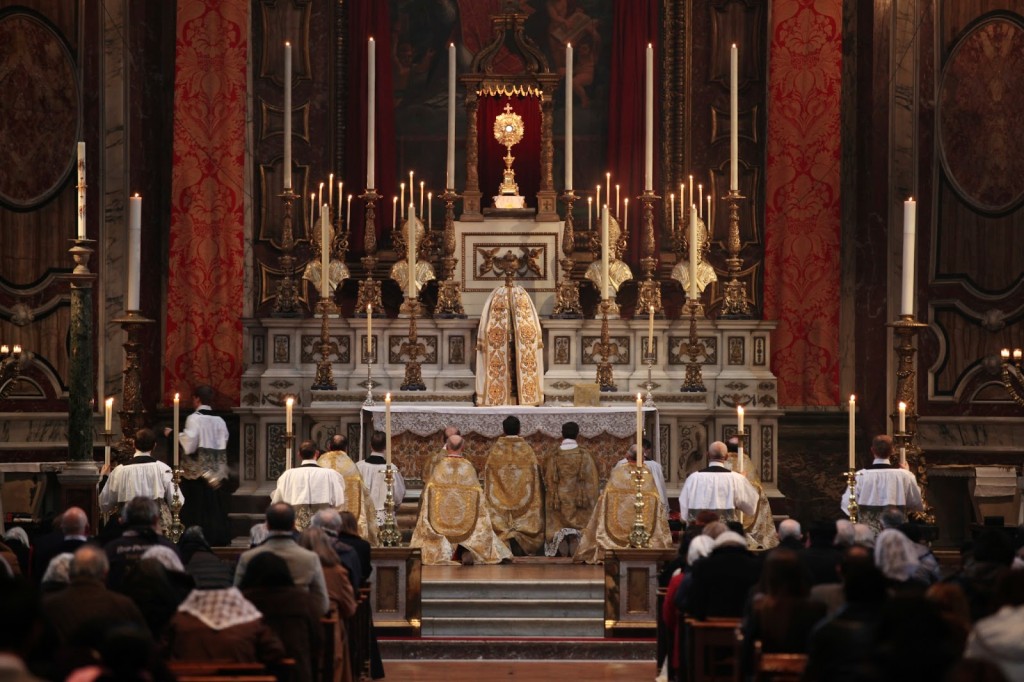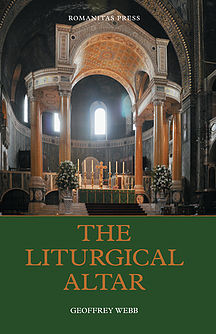 Several weeks ago, I posted an interview with one of the world’s foremost experts on the Tradition Roman Rite, Founder of Romanitas Press, Louis J. Tofari.
Several weeks ago, I posted an interview with one of the world’s foremost experts on the Tradition Roman Rite, Founder of Romanitas Press, Louis J. Tofari.
Based on the responses that both Louis and I received afterwards, it is obvious that even those who have assisted at the Traditional Latin Mass for some time have very good questions about specific liturgical practices and how they came about; i.e., why we do what we do at Holy Mass.

No surprise here… I think most readers of this space realize that the Roman Rite is so glorious that we can spend an entire lifetime exploring its riches.
Well, Louis Tofari has done, and continues to do, just that. He is a tremendous resource.
With this in mind, I’m truly honored to announce that akaCatholic, starting today, is launching a new regular feature: Roman Rite Q&A, where readers are invited to submit whatever questions they may have about the Traditional Roman Rite, whether they be historical, rubrical, symbolic, pastoral, or otherwise.
Louis is also incredibly well-versed in the origins of the Novus Ordo for those who are perhaps beginning to question its peculiarities.
So, whether you are new to tradition, a layperson, an acolyte, or a clergyman, please feel free to submit your questions, via email, to RomanRite@akaCatholic.com.
NOTE: The identities of those who submit questions will not be posted. (This may be especially important for any Novus Ordo priests who are just beginning to question the new Mass and are perhaps giving serious consideration to learning and celebrating the Traditional Latin Mass.)
At this, it is with sincere gratitude to Louis Tofari that I offer the first installment of Roman Rite Q&A.
___________________________________________________________
Dear Louis,
In my parish, for the Missa Cantata, the choir sings the Sanctus in two parts.
As expected, they being: Sanctus, Sanctus, Sanctus, Dominus Deus Sabaoth. Pleni sunt cæli et terra gloria tua. Hosanna in excelsis.
However, they always stop here and continue with Benedictus qui venit in nomine Domini. Hosanna in excelsis only after the consecration.
Is this an improper innovation, or does it have a place in the Church’s liturgical tradition?
*******
Thank you for you inquiry!
What you describe used to be a common practice, even with the Gregorian chant versions of the Sanctus.
The main reason for this splitting of the Sanctus into two parts, however, was due to lengthy polyphonic compositions of the Kyriale (e.g., the Palestrina Masses).
These polyphonic versions could be so long that it was impossible to finish the entire Sanctus before the Consecration. This resulted in the celebrant having to stop praying just before the Consecration itself, and even to wait some time until the Sanctus was finished.
Of course, the sacrificer and mediator should not be kept waiting! Hence arose the practice of splitting the Sanctus, which in some places was applied even to the chant versions of the Sanctus, even though this was not necessary timewise.
In 1958, the Sacred Congregation of Rites (which determined the rules for the liturgy) published its Instruction on Sacred Music and Liturgy; clarifying the rule for splitting the Sanctus:
- (d): If the Sanctus and Benedictus are sung to the Gregorian settings they are to be chanted without a break between them; otherwise Benedictus is to be sung after the Consecration.
If you’d like to read the full Instruction of the Sacred Congregation of Rites, you can find a digital version online at the Adoremus website. Note, the referral site is not entirely devoted to the traditional Mass, but it offers many good resources nonetheless.
___________________________________________________________
Please feel free to submit your questions about the Traditional Roman Rite, via email, to RomanRite@akaCatholic.com

As near as I can determine most of the publications dealing with the rubrics of the traditional Mass offered by Louis J. Tofari at the Romanitas Press refer to the 1962 Ordo promulgated by Paul VI. Other than the SSPX, FSSP and the secular parishes that offer the Indult Mass none of the “traditional” priests follow the 1962 Ordo. This was a transitional Ordo in preparation for the Novus Ordo. By 1962 Bugnini had already done significant damage to the order of Mass.
Those assisting at Masses celebrated by priests of the CMRI, Society of St Pius V and like minded priests (those who characterize the Popes after Pius XII as false popes) are largely following the Ordo of Pius V. For those interested in the rubrics and what they mean are likely to going to have to search for out of print guides—-like those authored by O’Connell and published before 1948 when Bugnini began his destructive work.
AsHhghost_03 pointed out, the so-called Traditional Mass that everyone outside of the sede’s talk about is not the Traditional Roman Rite Mass but the interim Mass Bugnini used to introduce the heretical Novus Ordo, using the same tactics as Cromwell to fool the people into believing the Catholic religion had not been replaced with the new religion of Modernism.
Readers will have to look to a sede website if they want to learn about the uncorrupted Mass of the Council of Trent and Pope Pius V.
Here is a link for one such site:
http://www.theholymass.com/
It is inaccurate to continually blame Bugnini for the destruction of the liturgy. Bugnini was just a tool, used first by Pius XII to change Holy Week. Later on, Paul VI used Bugnini and others, to craft the Novus Ordo Missae. The responsibility lies solely with the Popes and no one else.
That’s a great idea and should be of great benefit to people. May I take this opportunity to give you, Mr Verrechio and all your Family and all the readers and commenters, and all the suffering remnant a blessed and peaceful Holy Christmas- tide. Thank you.
I would argue that a Pope cant destroy the Liturgy, but an anti-pope sure can.
Then you need to change Pius XII’s status from a Pope to an anti-Pope.
Perhaps you are right.
I would like to point out that it was Pope John XXIII who promulgated the 1962 edition of the Missale Romanum, not Pope Paul VI (that was the transitional 1965, etc. that was based upon the 1962).
Furthermore, the reforms of the 1960 code of rubrics that comprised the 1962 edition were not the result of Bugnini (who had next to no influence whatsoever at that time — see the diaries and accounts of those who were there at that time, which was quite different than the later period of the Consilium) but of the Pius XII Liturgical Commission, which by the way, was being influenced by at least 150 years of discussions about liturgical reform, and in fact, some of the revisions were even being considered by the Council of Trent’s commission.
Furthermore, in no way can the doctrinally-orthodox 1962 (or even 1965) editions of the Missale Romanum be compared to the heterodox Novus Ordo Missae.
I hope that these comments sufficiently clarifies this issue for the time being.
Sorry, but as I clarify above, this is simply not true what is being said about the 1962 M.R.
But that being said, do you even know what the so-called “Mass of Pius V” even was?
I think you would be very surprised to find out what was added to the Roman Missal after the publication of “Quo Primum” even just ~30 and ~60 years later successively and which you take for granted to have been present in the codified missal promulgated by Pius V.
No matter what your position this is well worth a watch part 1 of 13
https://youtu.be/JdfUm_c8gCs